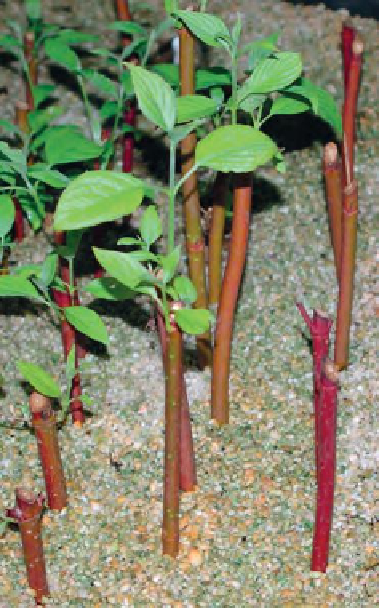Agriculture Reference
In-Depth Information
Figure 11.11
Mist propagation unit
Figure 11.12
Hardwood cuttings
plants, keep in polythene bags and use as quickly as
possible.
The area of leaf on these cuttings should be kept to a
minimum to reduce water loss. Misting (spraying the
plants with fine droplets of water to increase humidity
and reduce temperature) can further reduce this risk
by slowing down the transpiration rate. Automatic
misting (Figure 11.11) employs a switch attached to
a sensitive device that assesses the evaporation rate
from the leaves.
For plants such as
Chrysathemum
spp. it is often
better for amateurs and small growers with limited
propagation space to obtain rooted cuttings from
specialist propagators because then all that is required
is an area of reduced light where high humidity
(misting) can be maintained for 2-3 days until root
growth begins. If they cannot be 'stuck' immediately,
the cuttings can be stored in a refrigerator (at 1-5°C)
for several days.
Leaf cuttings
include leaf lamina and leaf petiole
cuttings. There are several ways by which leaf
lamina cuttings may be taken. One method suitable
for
Begonia rex
is to take whole leaves or just small
squares of the leaf and pin down so the veins make
good contact with a free-draining compost in a tray,
keeping them humid and at 20°C; plantlets develop
along the length of the veins in 6-8 weeks. A similar
method is used for
Streptocarpus
cvs
but the whole
leaf is split along the midrib, which is removed, and
the cut edges are inserted into trays of compost.
Leaf petiole cuttings are taken from
Peperomia
spp.,
using mature leaves, and
Saintpaulia
cvs, with full-
grown young leaves, with 5 cm of leaf stalk. This is
inserted into the compost; rooted plantlets can be
detached from the petioles after about eight weeks.
Semi-ripe cuttings
are taken from stems that are
just becoming woody (partially mature wood of the
current season's growth); typically, in mid-summer to
early autumn. They are used for many broadleaved
evergreen shrubs and some conifers such as
Chamaecyparis
spp. These cuttings should be 5-10 cm
long with the base firm but the tip soft active growth.
Rooting in a sand/compost mixture may be achieved
in cold frames or, more quickly, in a heated structure
at about 18°C. Some species such as
Elaeagnus
spp.
(oleaster) will root only if heat is provided.
Heeled cuttings
are preferred for many shrub and
tree species (e.g.
Ceanothus
, holly and conifers), by
which the semi-ripe cutting is taken in such a way that
about a centimetre sliver of the previous year's wood,
the
heel
, is still attached. The heel cambium facilitates
root formation and, hence, easier establishment.
However, it is a method which is not attractive for
commercial production because it removes basal buds
from the mother plant and in so doing prevents any
future regrowth.


